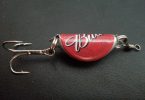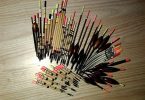Just how does a fish swim – and why do some fish virtually have to be taught the skill?
Like all living organisms, each species of fish is adapted to the particular environment in which it lives. Some of these adaptations are so obvious that we take them for granted; others are much more subtle. In all species of fish, however, the need to swim is obviously vital to the well-being of the individual, to enable it to maintain its position against the water current, to search for food, move to its spawning grounds, and so on.
Even a cursory study of the shape of a fish reveals much about its life-style. Many species which live habitually in fast-flowing water have evolved a body form which is round or oval in cross-section, offering reduced resistance to the water current. This need is less important for fish adapted to still or slow-flowing water conditions, which may possess a more deep-bodied shape. Again, the evolution of some bottom-dwelling species has resulted in triangular-shaped fish, the flattened belly helping to anchor the fish on the river bed.
When fish swim, they rely on their flank muscles, connected to the highly-efficient system of levers which forms the backbone, as their means of propulsion. Fish muscles, which form a large proportion of a fish’s body, are arranged in blocks along each side. As the muscles on one flank contract, those on the other relax, thereby causing the body to flex. The contraction and relaxation are slightly out of phase and produce a bend in the shape of the backbone.
The resultant wave moves down the fish from head to tail, by which time it has become amplified, and this whip-like motion exerts pressure on the surrounding water and produces forward thrust. The single fins on the back and belly of a fish act as keels, preventing pitch and roll, and the paired fins serve as brakes which allow the fish to turn to one side or the other.
Many people have attempted to make accurate measurements of the speed at which various fish swim, either by timing them over known distances in their natural environment or by determining their performance in man-made swimming channels. From these studies, we can broadly categorise fish into four groups:-
‘Sneakers’, such as eels, are capable only of slow speeds but possess some staying power;
‘Stayers’, like grayling, can swim quite fast over long periods;
‘Sprinters’ can generate fast bursts of speed (e.g. pike); and
‘Crawlers’ are sluggish swimmers, although they can accelerate slightly (bream, for example).
One type of sailfish is considered to be the fastest species of fish over short distances, achieving 68 mph over a three-second period, and anglers have recorded speeds in excess of 40 mph over longer periods for several species of tuna. If one considers a fish’s swimming capabilities in relation to its size, however, it is generally true that a small fish is a more able swimmer than a much larger one. On the other hand in terms of speed in miles per hour a big fish will, all other things being equal, be able to swim faster than a smaller fish.
The muscles involved in swimming are of two main types. The bulk of a fish’s body is composed of so-called white muscle, while the much smaller areas at the roots of the fins and in a strip along the centre of each flank comprise red muscle. The red muscle receives a good supply of blood and contains ample quantities of fat and glycogen, the storage form of glucose, which is used for most routine, day-to-day swimming movements. In contrast, the white muscle has a poor blood supply and few energy stores, and it is used largely for short-term, fast swimming.
It might seem odd that the body of an animal adapted so efficiently to its environment should be composed almost entirely of a type of muscle it rarely uses. However, this huge auxiliary power pack carried by a fish is of crucial significance if the life of the fish is threatened – by a predator, for instance – because it enables the fish to swim rapidly away from danger.
But the use of white muscle by a fish does have a knock-on effect on the fish’s internal body processes. Because of the poor blood system to the white muscle, these tissues receive little oxygen. When they are being used for prolonged periods, the energy stored within them cannot be ‘burnt off’ properly and an intermediate chemical, lactic acid, is produced. Since this substance is acidic, it can cause internal problems unless it is converted to harmless end products.
When the fish ceases using its white muscle, the lactic acid moves by diffusion to the red muscle, where the oxygen in the blood supply can burn it off completely. In the meantime, the fish suffers from an ‘oxygen debt’ which it must repay as soon as possible.
As most unfit people will testify, a similar situation occurs in humans when they run for a bus, say. Afterwards, heavy panting may occur, during which the body takes in enough air to pay off the body’ s oxygen debt and break down the lactic acid formed in the muscles.
There are, however, major differences between people and fish in the speed with which this reaction takes place. In human beings, panting may last for several minutes; in fish the equivalent process may last for several hours. During that time, the metabolism of the fish has to cope with the influx of lactic acid and, in severe circumstances, this may upset the internal chemistry of the fish to such an extent that its life is at risk.
Different types of fish possess differing proportions of red and white muscle. Not surprisingly, species adapted to running water have a greater amount of red muscle than those with a more sedentary existence and can cope with prolonged swimming more successfully.
Furthermore, an individual of a particular species accustomed to life in still water can be acclimatised to a more active way of life and develop a higher proportion of red muscle, although this may take several weeks, as it would with an athlete.
These facts have significance both to anglers and fishery managers. To the angler, it is important to realise that the act of hooking and playing a fish may lead to a build-up of lactic acid in its muscles. The less prolonged this enforced exercise, the smaller the amount of acid and the oxygen debt to be repaid.
The present-day equivalent of Hemingway’s story of ‘The Old Man and the Sea’ is usually described in angling articles as an ‘heroic struggle with monster fish on frail tackle’ – but it is debatable whether it is the angler or the fish that is more exhausted at the end. Better for the angler to use balanced tackle, of a strength designed to land the fish being sought, than inadequate equipment which necessitates a lengthy fight.
If the angler is seeking fish which are to be returned alive to the water, a fish which has fought in a prolonged manner should always be returned gently and supported, if necessary, until it regains its strength. To this end, a carefully-positioned keepnet or ‘tube’ can provide a safe, sheltered environment in which this recovery can take place.
There are lessons for the fishery manager to heed, too. When releasing stock fish into running water, it is important to avoid flood conditions, in which fish may be incapable of holding position in fierce currents. If fish transferred from or reared in still water are being stocked, this is of even more significance; people who ignore such advice should not be surprised to discover that their fish have migrated downstream (and, in some cases, they end up in the sea!).
Nowadays, the more far-sighted fish farmers, when raising fish in still waters, condition them in flowing water before releasing them into rivers and streams. Such fish are then trained for their new environment and will not simply drop downstream, to provide the owner of the neighbouring stretch with free extra stocks…
It may seem fantastic that some fish have to be taught to swim, but that’s what it amounts to!
Dr. Bruno Broughton – 2000







